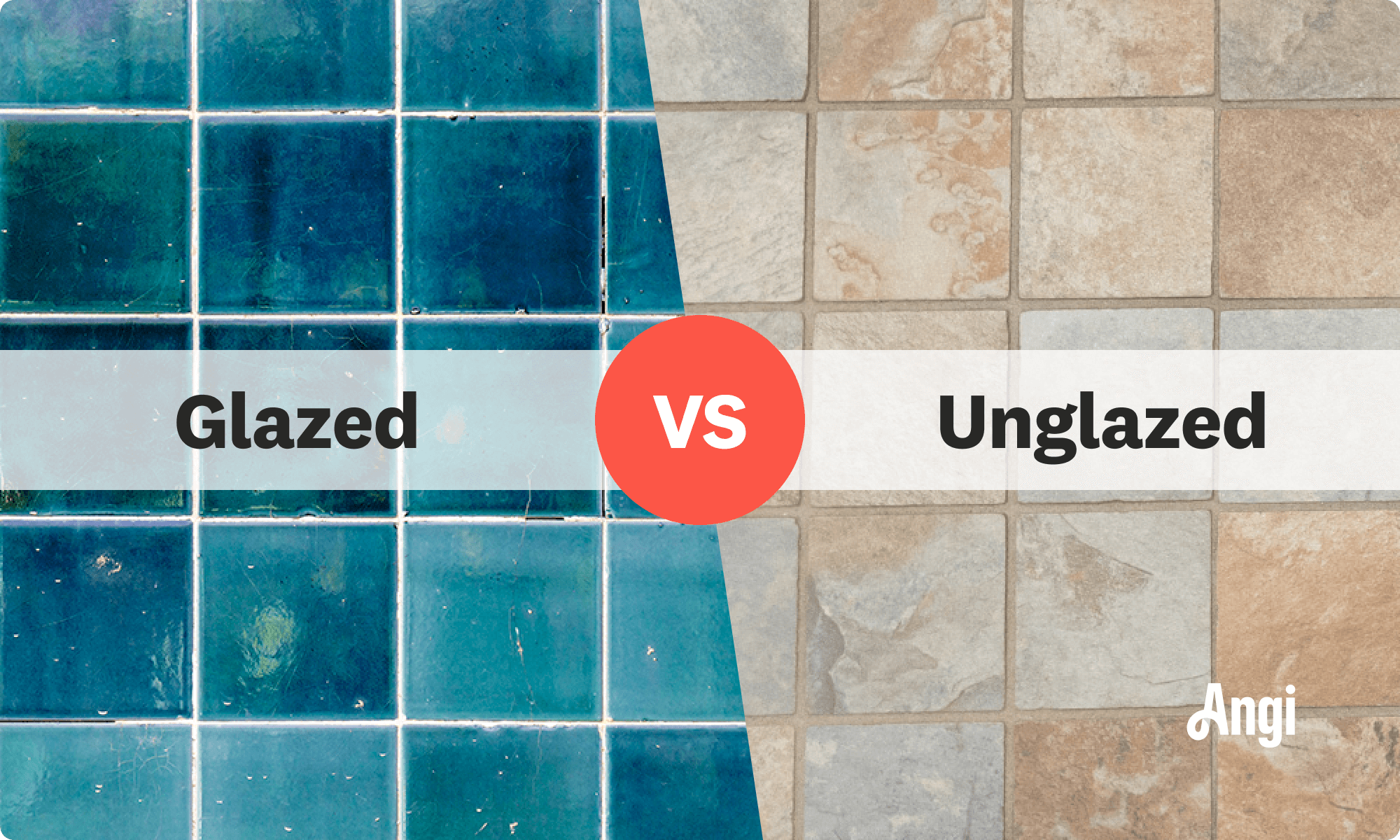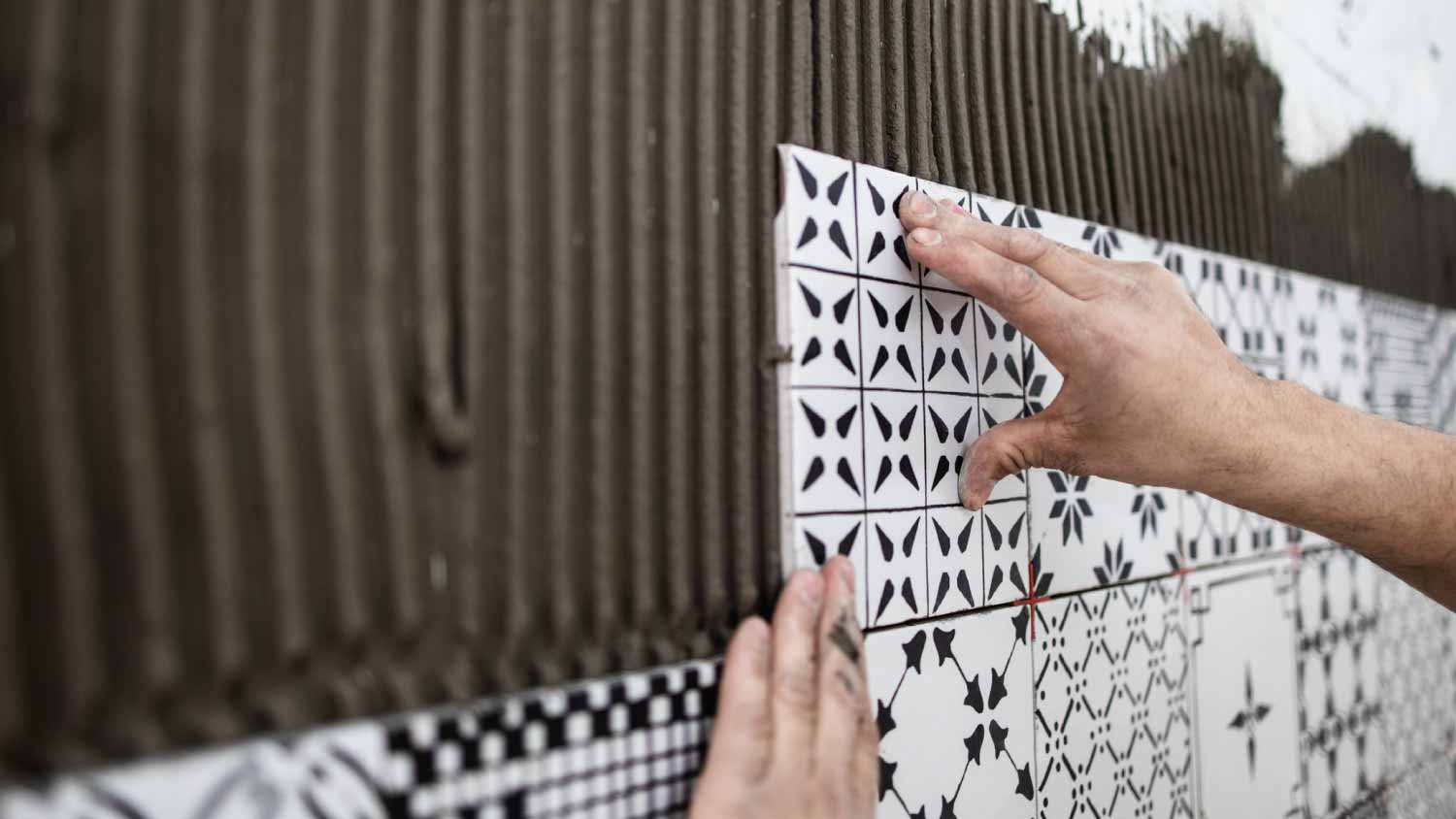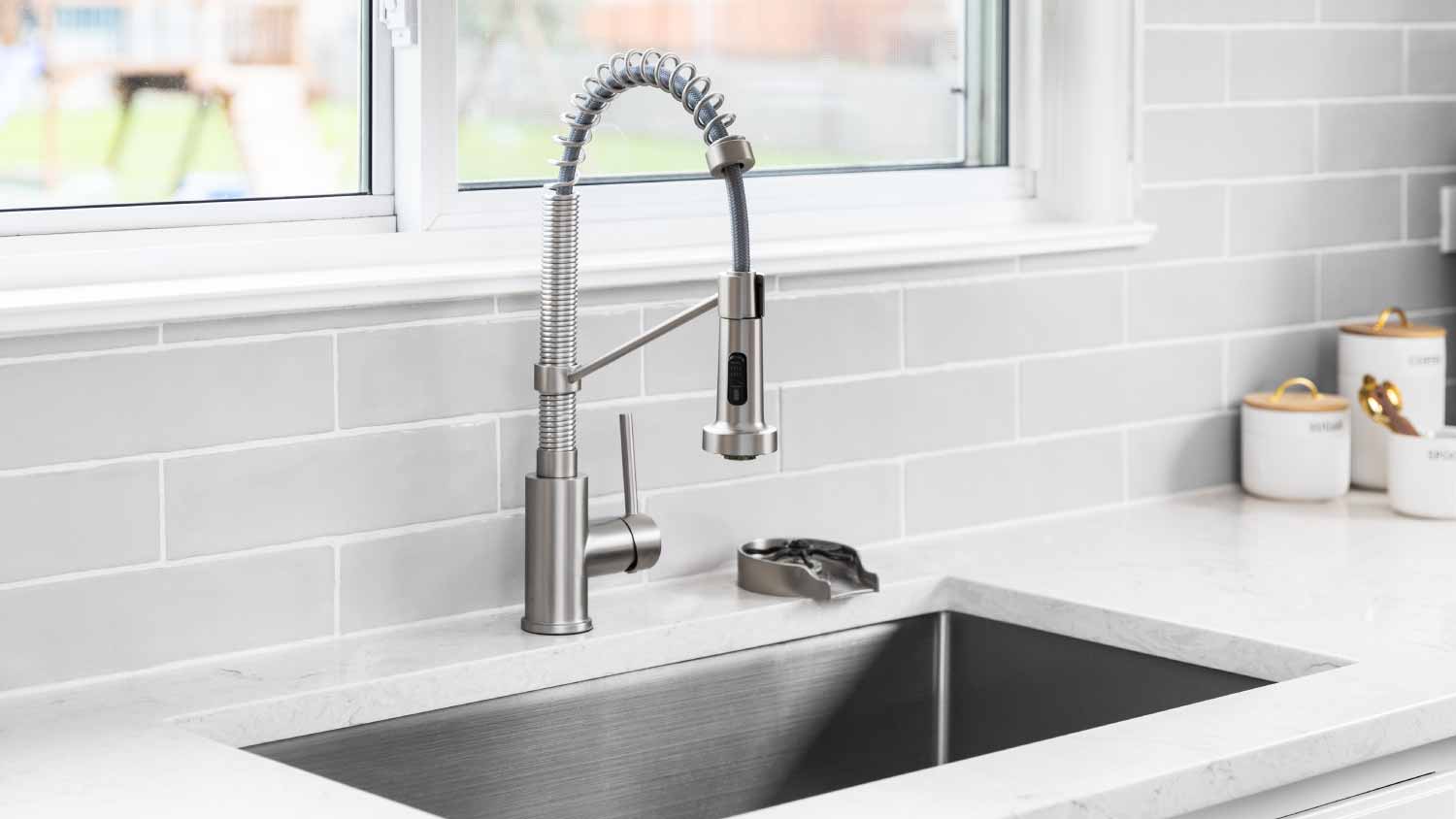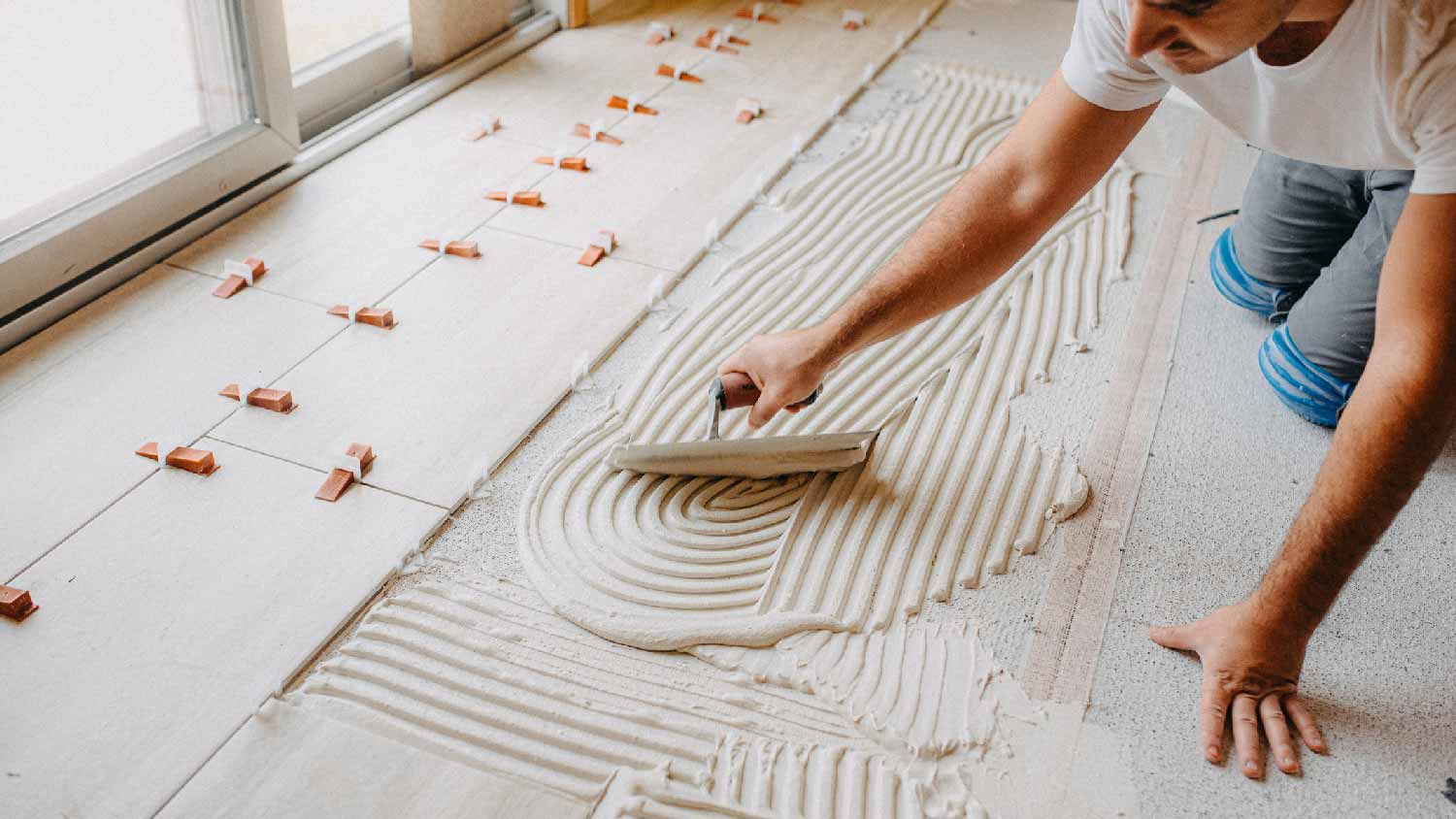
Damaged tiles should be fixed right away. In this guide, find out all of the different factors that affect your tile repair cost.
On average, it costs $4,800 to install ceramic tile. However, your project could cost $1,300 to $7,500, depending on the tile, room size, and similar factors. A pro can give you an accurate estimate for your specific project.


Installing ceramic tile costs anywhere from $600 to $18,000, but the average is about $12 to $45 per square foot of ceramic tile.
The type of tile also has an impact, with glazed tile averaging $4 to $15 per square foot and porcelain tile costing as much as $50 per square foot.
Tile removal, wall repair, and subfloor repair can also push up your total project cost.
For damaged tile, it might be cheaper to just repair it, which costs about $130 to $500.
The average ceramic tile installation costs $4,800, which comes out to $12 to $45 per square foot. Most projects range from $1,300 to $7,500, depending on the size of the space, the type of tile, and other variables. Below, we’ll dive into each of these factors to help you determine how much your ceramic tile installation will cost.
The amount of space you’re tiling influences your overall costs. When calculating how much tile you’ll need, use the square footage of the area plus an additional 20% to account for potential breakage and tiles that need to be cut.
| Square Footage | Average Installation Cost (Labor and Materials) |
|---|---|
| 50 | $600–$2,000 |
| 75 | $900–$3,375 |
| 100 | $1,200–$4,500 |
| 125 | $1,500–$5,625 |
| 150 | $1,800–$6,750 |
| 175 | $2,100–$7,875 |
| 200 | $2,400–$9,000 |
| 225 | $2,700–$10,125 |
| 250 | $3,000–$11,250 |
| 275 | $3,300–$12,375 |
| 300 | $3,600–$13,500 |

| Type | Average Cost per Square Foot |
|---|---|
| Glazed | $4–$15 |
| Unglazed | $3–$35 |
| Porcelain | $3–$50 |
Ceramic tile comes in glazed and unglazed versions, and the type you choose can impact your overall project costs. Glazed ceramic tiles are more widely available and feature a shiny layer that protects the tile from stains. On average, glazed ceramic tiles cost between $4 and $15 per square foot.
Unglazed ceramic tiles are rougher, making them a good option for outdoor spaces or places where you want to reduce the risk of people slipping and falling on wet tiles. Unglazed tiles range from $3 to $35 per square foot.
There are also porcelain tiles, which are sometimes grouped together with ceramic ones, since the main difference is the temperature at which they’re fired. However, porcelain tiles are more durable and water-resistant than ceramic. They cost between $3 and $50 per square foot.
In addition to the types of ceramic tile, there are also multiple shapes—each of which has a different price tag. Here’s how much you can expect to pay for the most popular tile shapes.
| Tile Shape | Average Cost per Square Foot |
|---|---|
| Square | $2–$10 |
| Rectangle | $2–$15 |
| Hexagon | $8–$20 |
| Mosaic | $10–$30 |
| Customized or non-standard | Up to $40 |

When you request a quote from a local ceramic tile installer, it should include the cost of labor and supplies, including tile, grout, sealant, spacers, and tools. (If you’re unsure what’s covered in your quote, ask your contractor.) Most tilers charge between $3 and $15 per square foot.
Every project is different, and some require more work than others. Here are some of the additional costs that you may encounter during ceramic tile installation.
If you’re replacing existing tile, you’ll need to factor in the price of tile removal. You should expect to spend between $2 and $7 per square foot for this type of work.
Sometimes, removing and installing tile can uncover other issues, like subfloor damage. On average, repairing a subfloor costs $3 to $10 per square foot.
Similarly, if you’re tiling a wall, you may need to make certain repairs before installation. Here are some of the most common fixes and their costs.
| Type of Damage | Average Repair Cost |
|---|---|
| Holes | $50–$400 |
| Stress cracks | $100–$150 |
| Water damage | $300–$800 |
| Bowing | $75–$400 per square foot |
| Sagging | $90–$100 per hour |
Small mosaic tiles or tiles with intricate patterns (for example, herringbone or basketweave) take longer to install than standard tile. As a result, they can increase your installation costs by 10% to 20%.

Whether you’re adding new tile flooring or replacing run-down shower tile, ceramic tile installation is time-consuming and labor-intensive.
As part of the job, you’ll need to use specialized tools and equipment to make precise cuts and arrange the tile neatly and evenly. There are also other aspects of the project—like inspecting and preparing the subfloor—that may be challenging for novice DIYers. For these reasons, we suggest hiring a professional to install ceramic tile.
However, if you have previous experience (and a good set of tiling tools), you can save $3 to $15 per square foot in labor by installing ceramic tile yourself. Assuming your subfloor is in good shape, you’d just need to buy tile, grout, and any tools you don’t already have.
If you have chipped, loose, or worn-out ceramic tile in your home, you might be wondering if it’s better to repair or replace the tile. Ultimately, the answer will depend on the type and severity of the damage, as well as your budget.
For example, let’s say you have a few cracked tiles on your kitchen floor. In most cases, repairing these tiles costs between $130 and $500. But if you opt for a full replacement, you’d need to shell out at least $1,240 for the new floor. If most of your tiles are loose or there’s water damage underneath them, you may need a complete replacement.
Tiling jobs can be pricey—especially when you use high-end tile or opt for professional installation. Still, there are ways to save money on a ceramic tile project. For example:
Buy tiles that are on sale or have been discontinued.
Opt for a mid-range tile that balances durability and affordability.
Avoid low-cost tiles that may break easily or require regular repairs.
Pick a standard tile size so that your installer doesn’t have to cut the tile into custom sizes.
Don’t use small mosaic tiles that need extra grout work.
Skip intricate tiling patterns (like herringbone and Versaille) that are labor-intensive to install.
Remove the old tile yourself.
Request quotes from multiple contractors.
Schedule your tiling project for the off-season, when prices tend to be lower.
Home is the most important place on earth, which is why Angi has helped more than 150 million homeowners transform their houses into homes they adore. To help homeowners with their next project, Angi provides readers with the most accurate cost data and upholds strict editorial standards. We extensively research project costs to develop the pricing data you see, so you can make the best decisions for you and your home. We rely on reputable sources, including the U.S. Bureau of Labor Statistics, academic journals, market studies, and interviews with industry experts—all to ensure our prices reflect real-world projects.
Want to help us improve our cost data? Send us a recent project quote to [email protected]. Quotes and personal information will not be shared publicly.
From average costs to expert advice, get all the answers you need to get your job done.

Damaged tiles should be fixed right away. In this guide, find out all of the different factors that affect your tile repair cost.

The cost to install travertine tile depends on materials and the size of the project. This guide to travertine tile cost will help you budget accordingly.

Discover the cost to regrout shower, including average prices, key cost factors, and tips to help you budget for a fresh, watertight shower.

If you recently tiled your kitchen or bathroom, you might wonder, does grout need to be sealed? Check out the reasons you shouldn’t skip sealing your grout.

Calculating how much thinset you need involves multiple steps. Use this guide to determine exactly how much of the bonding material you’ll need.

A loose floor tile can be a nuisance or a hazard, but fixing floor tiles may not be as hard as you think. Our DIY guide will show you how to fix loose floor tiles.